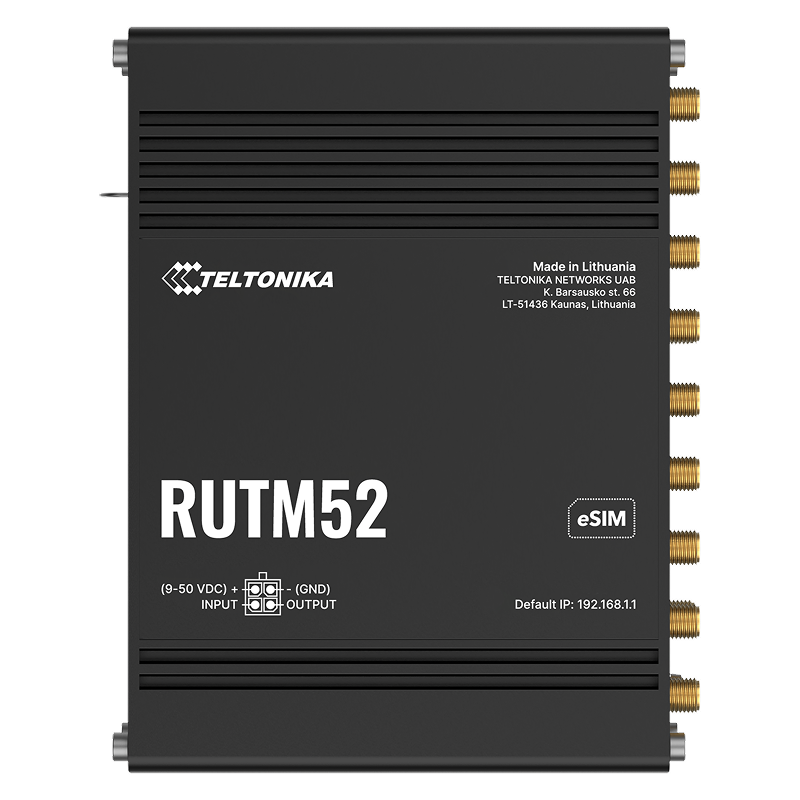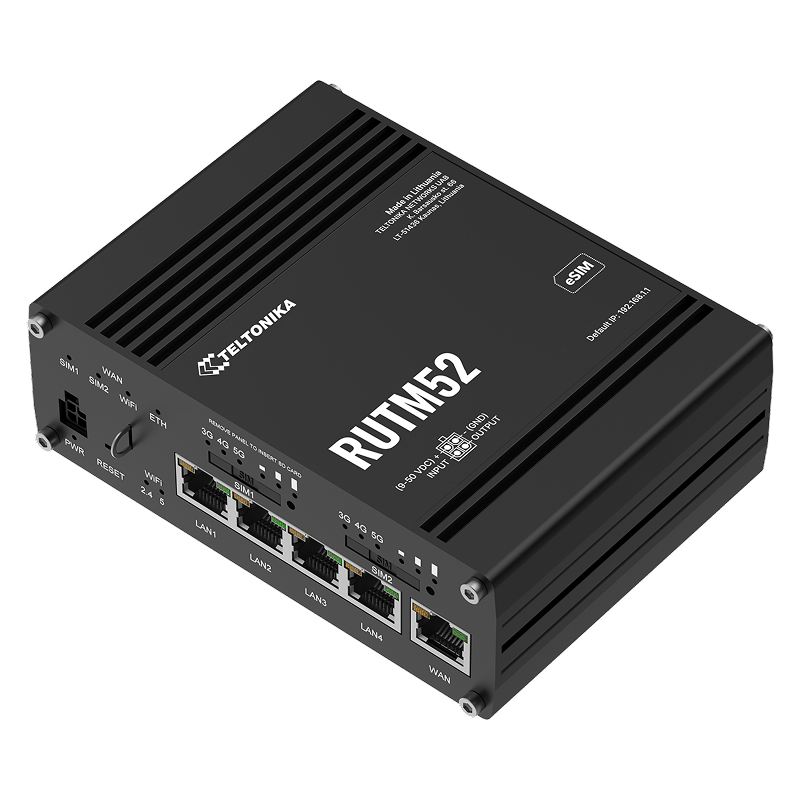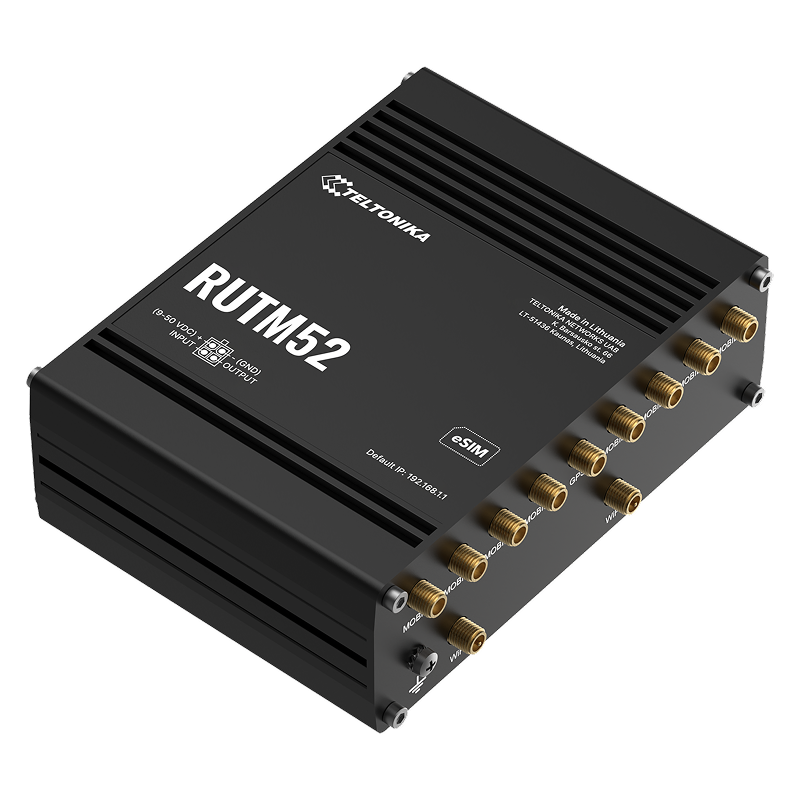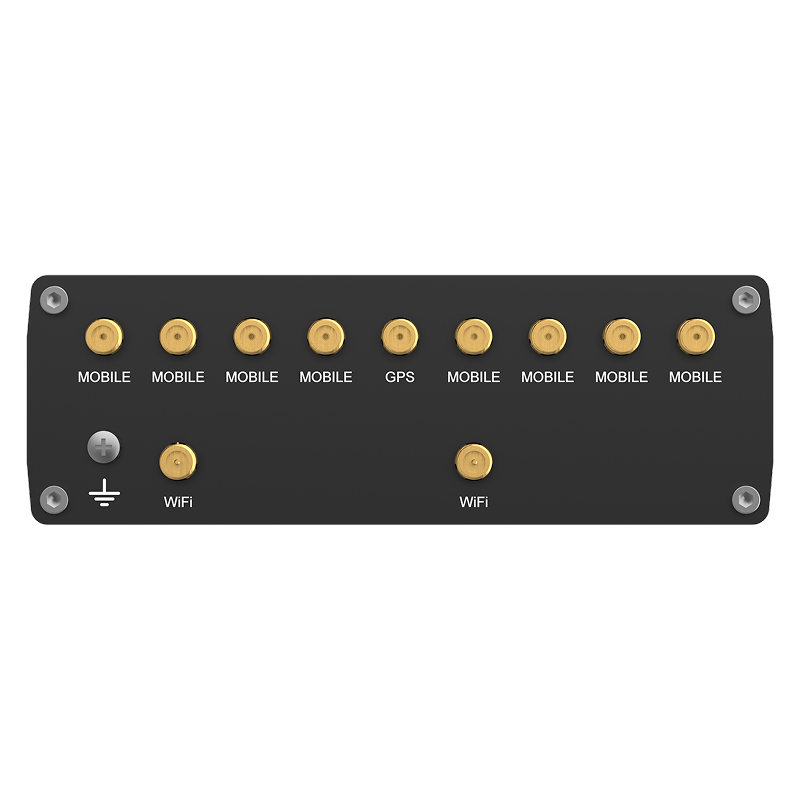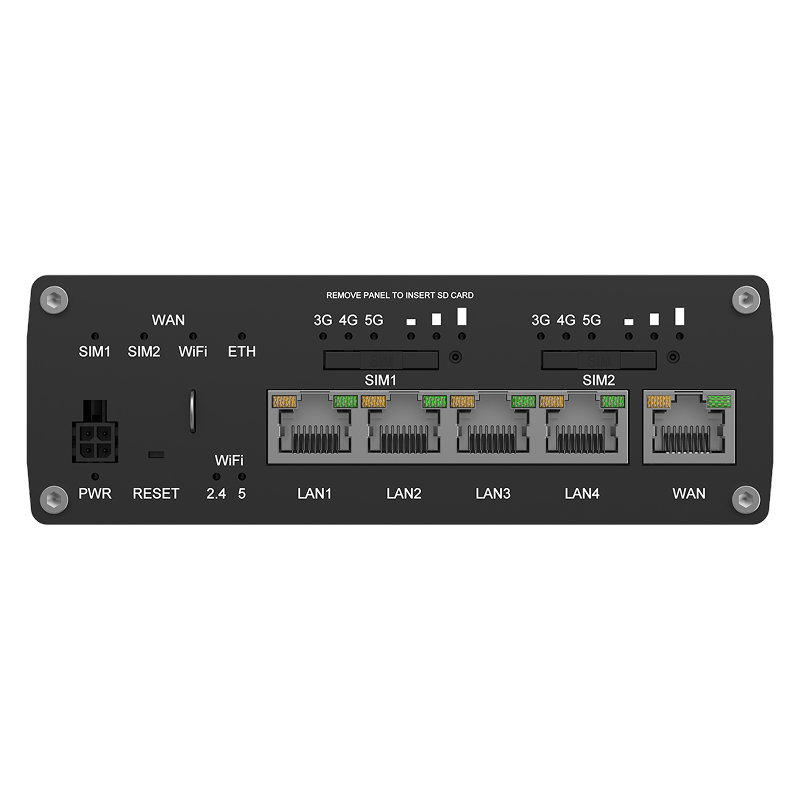




Tekniska specifikationer
Mobile
Cellular module: 2 x 5G Sub-6 GHz SA/NSA, download speed up to 2.1/3.3 Gbps (4x4 MIMO), upload up to 900/600 Mbps (2x2 MIMO)
4G (LTE): Download Cat 20 up to 2.0 Gbps (4x4 MIMO), upload Cat 20 up to 200 Mbps
3G: Download up to 42 Mbps, upload up to 5.76 Mbps
3GPP Release: Release 16
eSIM: Consumer-grade eSIM, supports profile download and deletion, up to 7 eSIM profiles; does not include data plans
SIM Switch: Ability to use dual modems with independent SIM switch for each modem. Automatic switching between physical SIM and eSIM based on signal strength, data limits, roaming and network issues. Both physical SIM cards can be used simultaneously, switching is done per modem.
Status information: IMSI, ICCID, operator, operator state, data connection status, network type, CA indicator, bandwidth, connected band, signal strength (RSSI), SINR, RSRP, RSRQ, EC/IO, RSCP, data sent/received, LAC, TAC, cell ID, ARFCN, UARFCN, EARFCN, MCC and MNC.
SMS: SMS status, SMS configuration, email to SMS, SMS to email, SMS to HTTP, SMS to SMS, scheduled SMS, automatic SMS replies, SMPP
USSD: Support for sending and reading USSD messages
Block/Allow list: Operator blocking/allowing (per country or individual operator)
Multiple PDNs: Ability to use different PDNs for multiple network accesses and services
Tape management: Tape lock function, display of used tapes
SIM PIN Management: Set, change, or disable your SIM card PIN
APN: Automatic APN configuration
Bridge: Direct connection between mobile operator and devices on LAN
Passthrough: The router assigns its mobile WAN IP address to another device on the LAN
Framed routing: Support for IP networks behind 5G UE (User Equipment)
4G (LTE): Download Cat 20 up to 2.0 Gbps (4x4 MIMO), upload Cat 20 up to 200 Mbps
3G: Download up to 42 Mbps, upload up to 5.76 Mbps
3GPP Release: Release 16
eSIM: Consumer-grade eSIM, supports profile download and deletion, up to 7 eSIM profiles; does not include data plans
SIM Switch: Ability to use dual modems with independent SIM switch for each modem. Automatic switching between physical SIM and eSIM based on signal strength, data limits, roaming and network issues. Both physical SIM cards can be used simultaneously, switching is done per modem.
Status information: IMSI, ICCID, operator, operator state, data connection status, network type, CA indicator, bandwidth, connected band, signal strength (RSSI), SINR, RSRP, RSRQ, EC/IO, RSCP, data sent/received, LAC, TAC, cell ID, ARFCN, UARFCN, EARFCN, MCC and MNC.
SMS: SMS status, SMS configuration, email to SMS, SMS to email, SMS to HTTP, SMS to SMS, scheduled SMS, automatic SMS replies, SMPP
USSD: Support for sending and reading USSD messages
Block/Allow list: Operator blocking/allowing (per country or individual operator)
Multiple PDNs: Ability to use different PDNs for multiple network accesses and services
Tape management: Tape lock function, display of used tapes
SIM PIN Management: Set, change, or disable your SIM card PIN
APN: Automatic APN configuration
Bridge: Direct connection between mobile operator and devices on LAN
Passthrough: The router assigns its mobile WAN IP address to another device on the LAN
Framed routing: Support for IP networks behind 5G UE (User Equipment)
Wireless
Wireless mode: 802.11b/g/n/ac Wave 2 (Wi-Fi 5) with up to 867 Mbps, Dual Band, MU-MIMO
WiFi Security: WPA2-Enterprise (PEAP), WPA2-PSK, WPA-EAP, WPA-PSK, WPA3-SAE, WPA3-EAP, OWE; AES-CCMP, TKIP, automatic encryption mode, client separation, EAP-TLS with PKCS#12 certificate, option to disable automatic reconnection, 802.11w Protected Management Frames (PMF)
SSID/ESSID: ESSID hidden function
Wi-Fi users: Up to 150 simultaneous connections
Wireless features: Wireless mesh (802.11s), fast roaming (802.11r), Relayd, BSS transition management (802.11v), radio measurement features (802.11k)
Wireless MAC Filter: Allow and Block Lists
Wireless QR code generator: Scan to automatically connect to the network without logging in
TravelMate: Forwards the Wi-Fi hotspot landing page to the next connected device
WiFi Security: WPA2-Enterprise (PEAP), WPA2-PSK, WPA-EAP, WPA-PSK, WPA3-SAE, WPA3-EAP, OWE; AES-CCMP, TKIP, automatic encryption mode, client separation, EAP-TLS with PKCS#12 certificate, option to disable automatic reconnection, 802.11w Protected Management Frames (PMF)
SSID/ESSID: ESSID hidden function
Wi-Fi users: Up to 150 simultaneous connections
Wireless features: Wireless mesh (802.11s), fast roaming (802.11r), Relayd, BSS transition management (802.11v), radio measurement features (802.11k)
Wireless MAC Filter: Allow and Block Lists
Wireless QR code generator: Scan to automatically connect to the network without logging in
TravelMate: Forwards the Wi-Fi hotspot landing page to the next connected device
Ethernet
WAN port: 1 x WAN port, 10/100/1000 Mbps, complies with IEEE 802.3, 802.3u, 802.3az, supports auto MDI/MDIX crossover
LAN ports: 4 x LAN ports, 10/100/1000 Mbps, complies with IEEE 802.3, 802.3u, 802.3az, supports auto MDI/MDIX crossover
LAN ports: 4 x LAN ports, 10/100/1000 Mbps, complies with IEEE 802.3, 802.3u, 802.3az, supports auto MDI/MDIX crossover
Network
Routing: Static routing, dynamic routing (BGP, OSPF v2, RIP v1/v2, EIGRP, NHRP), policy-based routing
Protocol: TCP, UDP, IPv4, IPv6, ICMP, NTP, DNS, HTTP, HTTPS, FTP, SMTP, SSL v3, TLS, ARP, VRRP, PPP, PPPoE, UPnP, SSH, DHCP, Telnet, SMPP, SNMP, MQTT, Wake On LAN (WOL), VXLAN
VoIP support: H.323 and SIP-alg protocols NAT helper for correct VoIP routing
Connection monitoring: Ping reboot, Wget reboot, periodic reboot, LCP and ICMP for link inspection
Firewall: Port forwarding, traffic rules, custom rules, TTL target customization
Firewall status: Statistics and display of firewall rules and counts
Port management: View and change status, enable/disable ports, adjust speed, auto-configuration, etc.
Network topology: Visual representation of the network and connected devices
Hotspot: Captive portal with internal/external Radius server, MAC authentication, SMS authorization, SSO, user management, multiple customizable themes
DHCP: Static and dynamic IP assignment, DHCP relay, DHCP server and static leases
QoS / Smart Queue Management: Prioritization of traffic by source/destination, service, protocol or port, WMM, 802.11e
DDNS: Support for over 25 service providers, manual configuration possible
DNS over HTTPS: Secure DNS resolution via HTTPS
Network backup: Wi-Fi WAN, cellular, VRRP, and wired connections as automatic failover options
Load Balancing: Distribution of Internet traffic across multiple WAN connections
SSHFS: Mount remote filesystems via SSH
VRF support: Virtual Routing and Forwarding (VRF) is supported
Traffic management: Real-time monitoring, wireless signal graphs, traffic consumption history
Protocol: TCP, UDP, IPv4, IPv6, ICMP, NTP, DNS, HTTP, HTTPS, FTP, SMTP, SSL v3, TLS, ARP, VRRP, PPP, PPPoE, UPnP, SSH, DHCP, Telnet, SMPP, SNMP, MQTT, Wake On LAN (WOL), VXLAN
VoIP support: H.323 and SIP-alg protocols NAT helper for correct VoIP routing
Connection monitoring: Ping reboot, Wget reboot, periodic reboot, LCP and ICMP for link inspection
Firewall: Port forwarding, traffic rules, custom rules, TTL target customization
Firewall status: Statistics and display of firewall rules and counts
Port management: View and change status, enable/disable ports, adjust speed, auto-configuration, etc.
Network topology: Visual representation of the network and connected devices
Hotspot: Captive portal with internal/external Radius server, MAC authentication, SMS authorization, SSO, user management, multiple customizable themes
DHCP: Static and dynamic IP assignment, DHCP relay, DHCP server and static leases
QoS / Smart Queue Management: Prioritization of traffic by source/destination, service, protocol or port, WMM, 802.11e
DDNS: Support for over 25 service providers, manual configuration possible
DNS over HTTPS: Secure DNS resolution via HTTPS
Network backup: Wi-Fi WAN, cellular, VRRP, and wired connections as automatic failover options
Load Balancing: Distribution of Internet traffic across multiple WAN connections
SSHFS: Mount remote filesystems via SSH
VRF support: Virtual Routing and Forwarding (VRF) is supported
Traffic management: Real-time monitoring, wireless signal graphs, traffic consumption history
Security
802.1x: Port-based network access control client
Authentication: Distributed keys, digital and X.509 certificates, TACACS+, RADIUS users, IP and login blocking, timed login, random password generator
Firewall: Pre-configured rules via web interface, unlimited configuration via CLI, DMZ, NAT, NAT-T, NAT64
Attack protection: DDOS protection (SYN flood, SSH, HTTP/HTTPS), port scanning protection
VLAN: Port and tag-based VLAN separation
Mobile data quota: Check and alert mobile data usage
WEB Filter: Blacklists and whitelists for web access
Access Control: Flexible control for SSH, web interface, CLI and Telnet
TPM: Security module for identification and authentication, TPM 2.0 standard
SSL certificate: Generation via Let's Encrypt and SCEP
Authentication: Distributed keys, digital and X.509 certificates, TACACS+, RADIUS users, IP and login blocking, timed login, random password generator
Firewall: Pre-configured rules via web interface, unlimited configuration via CLI, DMZ, NAT, NAT-T, NAT64
Attack protection: DDOS protection (SYN flood, SSH, HTTP/HTTPS), port scanning protection
VLAN: Port and tag-based VLAN separation
Mobile data quota: Check and alert mobile data usage
WEB Filter: Blacklists and whitelists for web access
Access Control: Flexible control for SSH, web interface, CLI and Telnet
TPM: Security module for identification and authentication, TPM 2.0 standard
SSL certificate: Generation via Let's Encrypt and SCEP
OPC UA
Supported modes: Client, Server
Supported connection types: TCP
Supported connection types: TCP
MODBUS
Supported modes: Server, Client
Supported connection types: TCP
Custom registers: MODBUS TCP custom register blocks that can read/write to a file in the router, to extend the functionality of the MODBUS TCP client.
Supported data formats:8-bit: INT, UINT
16-bit: INT, UINT (MSB or LSB first)
32-bit: float, INT, UINT (ABCD - big-endian, DCBA - little-endian, CDAB, BADC), HEX, ASCII
Supported connection types: TCP
Custom registers: MODBUS TCP custom register blocks that can read/write to a file in the router, to extend the functionality of the MODBUS TCP client.
Supported data formats:8-bit: INT, UINT
16-bit: INT, UINT (MSB or LSB first)
32-bit: float, INT, UINT (ABCD - big-endian, DCBA - little-endian, CDAB, BADC), HEX, ASCII
Data to server
Protocol: HTTP(S), MQTT, Azure MQTT
Function: Collect parameters from multiple sources and protocols and send them to a single server. Supports custom LUA scripting to use the router's "Data to server" feature.
Function: Collect parameters from multiple sources and protocols and send them to a single server. Supports custom LUA scripting to use the router's "Data to server" feature.
MQTT Gateway
Modbus MQTT Gateway: Send commands and receive data from MODBUS server via MQTT broker.
DNP3
Supported modes: DNP3 Station, DNP3 Outstation
Connection: TCP
Connection: TCP
DLMS/COSEM
DLMS support: Standard protocol for exchanging meter data
Supported modes: Client
Connection: TCP
COSEM: Scans the meter's COSEM objects for automatic detection and configuration.
Supported modes: Client
Connection: TCP
COSEM: Scans the meter's COSEM objects for automatic detection and configuration.
API
Teltonika Networks Web API (beta): Extend the capabilities of your device through configurable API endpoints to retrieve or modify data. More info: Teltonika Developers
VPN
OpenVPN: Multiple clients and one server can run simultaneously. Supports 27 different encryption methods.
OpenVPN encryption: DES-CBC 64, RC2-CBC 128, DES-EDE-CBC 128, DES-EDE3-CBC 192, DESX-CBC 192,
BF-CBC 128, RC2-40-CBC 40, CAST5-CBC 128, RC2-64-CBC 64, AES-128-CBC 128, AES-128-CFB 128, AES-128-CFB1 128, AES-128-CFB8 128, AES-128-OFB 128, AES-128-GCM 128, AES-192-CFB 192, AES-192-CFB1 192, AES-192-CFB8 192, AES-192-OFB 192, AES-192-CBC 192, AES-192-GCM 192, AES-256-GCM 256, AES-256-CFB 256, AES-256-CFB1 256, AES-256-CFB8 256, AES-256-OFB 256, AES-256-CBC 256.
IPsec: Support for XFRM, IKEv1, IKEv2 with 14 encryption methods (3DES, DES, AES128, AES192, AES256, AES128GCM8, AES192GCM8, AES256GCM8, AES128GCM12, AES192GCM12, AES256GCM12, AES128GCM16, AES192GCM16, AES256GCM16).
GRE: GRE tunnel and GRE tunnel over IPsec support.
PPTP, L2TP: Client and server instances can run simultaneously. Support for L2TPv3 and L2TP over IPsec.
Stunnel: Proxy that adds TLS encryption to existing clients and servers without changing their code.
DMVP: Method for building scalable IPsec VPNs, support for Phase 2 and Phase 3 and Dual Hub.
SSTP: SSTP client support.
ZeroTier: ZeroTier VPN client support.
WireGuard: WireGuard VPN client and server support.
Tinc: Tinc offers encryption, authentication, and compression in its tunnels. Client and server support.
Tailscale: Tailscale offers speed, stability, and simplicity over traditional VPNs. Encrypted point-to-point connections using the open WireGuard protocol.
OpenVPN encryption: DES-CBC 64, RC2-CBC 128, DES-EDE-CBC 128, DES-EDE3-CBC 192, DESX-CBC 192,
BF-CBC 128, RC2-40-CBC 40, CAST5-CBC 128, RC2-64-CBC 64, AES-128-CBC 128, AES-128-CFB 128, AES-128-CFB1 128, AES-128-CFB8 128, AES-128-OFB 128, AES-128-GCM 128, AES-192-CFB 192, AES-192-CFB1 192, AES-192-CFB8 192, AES-192-OFB 192, AES-192-CBC 192, AES-192-GCM 192, AES-256-GCM 256, AES-256-CFB 256, AES-256-CFB1 256, AES-256-CFB8 256, AES-256-OFB 256, AES-256-CBC 256.
IPsec: Support for XFRM, IKEv1, IKEv2 with 14 encryption methods (3DES, DES, AES128, AES192, AES256, AES128GCM8, AES192GCM8, AES256GCM8, AES128GCM12, AES192GCM12, AES256GCM12, AES128GCM16, AES192GCM16, AES256GCM16).
GRE: GRE tunnel and GRE tunnel over IPsec support.
PPTP, L2TP: Client and server instances can run simultaneously. Support for L2TPv3 and L2TP over IPsec.
Stunnel: Proxy that adds TLS encryption to existing clients and servers without changing their code.
DMVP: Method for building scalable IPsec VPNs, support for Phase 2 and Phase 3 and Dual Hub.
SSTP: SSTP client support.
ZeroTier: ZeroTier VPN client support.
WireGuard: WireGuard VPN client and server support.
Tinc: Tinc offers encryption, authentication, and compression in its tunnels. Client and server support.
Tailscale: Tailscale offers speed, stability, and simplicity over traditional VPNs. Encrypted point-to-point connections using the open WireGuard protocol.
Monitoring & management
WEB UI: HTTP/HTTPS, status, configuration, firmware update, CLI, troubleshooting, multiple event log servers, notification of available firmware updates, system logs, internet status.
FOTA: Firmware update from server, automatic notification.
SSH: SSH versions 1 and 2.
SMS: Status and configuration.
Calls: Reboot, status, mobile data on/off, output on/off, answer/hang up with timer, Wi-Fi on/off.
Email: Receive status alerts via email.
TR-069: Support for various ACS servers such as OpenACS, EasyCwmp, LibreACS and more.
MQTT: MQTT broker and publisher.
SNMP: Version 1, 2, 3, SNMP Trap and protection against brute force attacks.
JSON-RPC: Management API over HTTP/HTTPS.
RMS: Teltonika Remote Management System.
FOTA: Firmware update from server, automatic notification.
SSH: SSH versions 1 and 2.
SMS: Status and configuration.
Calls: Reboot, status, mobile data on/off, output on/off, answer/hang up with timer, Wi-Fi on/off.
Email: Receive status alerts via email.
TR-069: Support for various ACS servers such as OpenACS, EasyCwmp, LibreACS and more.
MQTT: MQTT broker and publisher.
SNMP: Version 1, 2, 3, SNMP Trap and protection against brute force attacks.
JSON-RPC: Management API over HTTP/HTTPS.
RMS: Teltonika Remote Management System.
IoT platforms
ThingWorx: Monitors WAN type, IP, mobile operator, signal strength, and network type.
Cumulocity: Monitors model, revision, serial number, WAN type/IP, mobile cell ID, ICCID, IMEI, connection type, operator, signal strength. Can also reboot and upgrade firmware.
Azure IoT Hub: Can be configured to send all parameters to the cloud. Supports Direct method and Device Provisioning Service for automatic configuration.
AWS IoT Core: Interaction with the AWS cloud platform. Support for Jobs functionality
Cumulocity: Monitors model, revision, serial number, WAN type/IP, mobile cell ID, ICCID, IMEI, connection type, operator, signal strength. Can also reboot and upgrade firmware.
Azure IoT Hub: Can be configured to send all parameters to the cloud. Supports Direct method and Device Provisioning Service for automatic configuration.
AWS IoT Core: Interaction with the AWS cloud platform. Support for Jobs functionality
System properties
CPU: MediaTek, Dual-Core, 880 MHz, MIPS1004Kc
RAM: 256MB DDR3
Flash storage: 16 MB serial NOR flash, 256 MB serial NAND flash
RAM: 256MB DDR3
Flash storage: 16 MB serial NOR flash, 256 MB serial NAND flash
Firmware / Configuration
WEB UI: Firmware update from file, check firmware on server, configuration profiles, backup.
FOTA: Firmware update.
RMS: Firmware and configuration update for multiple devices at the same time.
Keep settings: Update firmware without losing configuration.
Reset: Factory reset resets all system settings including IP address, PIN, and user data.
FOTA: Firmware update.
RMS: Firmware and configuration update for multiple devices at the same time.
Keep settings: Update firmware without losing configuration.
Reset: Factory reset resets all system settings including IP address, PIN, and user data.
Firmware customization
Operating system: RutOS (based on OpenWrt Linux)
Supported languages: Busybox shell, Lua, C, C++
Development tools: SDK with build environment included
GPL Customization: Create your own custom firmware with changes to colors, logos, and other elements.
Package manager: Used to install additional software on the device.
Supported languages: Busybox shell, Lua, C, C++
Development tools: SDK with build environment included
GPL Customization: Create your own custom firmware with changes to colors, logos, and other elements.
Package manager: Used to install additional software on the device.
Positioning
GNSS: GPS, GLONASS, BeiDou, Galileo, QZSS
Coordinates: Via WebUI, SMS, TAVL, RMS
NMEA: Support for NMEA 0183
NTRIP: Supports NTRIP protocol for RTCM over the internet
Server software: TAVL, RMS
Geofencing: Configurable multiple geofence zones.
Coordinates: Via WebUI, SMS, TAVL, RMS
NMEA: Support for NMEA 0183
NTRIP: Supports NTRIP protocol for RTCM over the internet
Server software: TAVL, RMS
Geofencing: Configurable multiple geofence zones.
Input / Output
Input: 1 digital input, 0-6 V detected as low, 8-50 V as high
Output: 1 digital output, open collector, max 50 V, 300 mA
Events: Email, RMS, SMS
I/O Juggler: Set conditions to trigger events.
Output: 1 digital output, open collector, max 50 V, 300 mA
Events: Email, RMS, SMS
I/O Juggler: Set conditions to trigger events.
Current
Connector: 4-pin industrial DC power connector
Input voltage: 9–50 V DC, reverse polarity and overvoltage protection >51 V (10 µs max)
PoE (passive): Can be powered via LAN1 port (not compatible with IEEE 802.3af/at/bt), Mode B, 9-50 V DC
Power consumption: Standby < 5 W, Max < 13 W
Input voltage: 9–50 V DC, reverse polarity and overvoltage protection >51 V (10 µs max)
PoE (passive): Can be powered via LAN1 port (not compatible with IEEE 802.3af/at/bt), Mode B, 9-50 V DC
Power consumption: Standby < 5 W, Max < 13 W
Physical interfaces
Ethernet: 5 x RJ45, 10/100/1000 Mbps
I/O: 1 digital input, 1 digital output on 4-pin connector
LED: 6 status LEDs, 6 signal strength LEDs, 10 Ethernet status LEDs, 4 WAN status LEDs, 1 power LED, 2 Wi-Fi LEDs (2.4G and 5G)
SIM: 2 x Mini SIM (2FF), 1.8 V/3 V
Antenna: 8 x SMA for cellular, 2 x RP-SMA for Wi-Fi, 1 x SMA for GNSS
Reset: Restart, user default reset, factory reset.
I/O: 1 digital input, 1 digital output on 4-pin connector
LED: 6 status LEDs, 6 signal strength LEDs, 10 Ethernet status LEDs, 4 WAN status LEDs, 1 power LED, 2 Wi-Fi LEDs (2.4G and 5G)
SIM: 2 x Mini SIM (2FF), 1.8 V/3 V
Antenna: 8 x SMA for cellular, 2 x RP-SMA for Wi-Fi, 1 x SMA for GNSS
Reset: Restart, user default reset, factory reset.
Other
Grounding screw: 1 pc.
Housing: Anodized aluminum
Dimensions: 132 x 44.2 x 95.1 mm
Weight: 560g
Mounting: DIN rail, wall, flat surface (accessories required)
Housing: Anodized aluminum
Dimensions: 132 x 44.2 x 95.1 mm
Weight: 560g
Mounting: DIN rail, wall, flat surface (accessories required)
Operating environment
Operating temperature: -40°C to 60°C
Operating humidity: 10% to 90% non-condensing
Ingress Protection Rating: IP30
Operating humidity: 10% to 90% non-condensing
Ingress Protection Rating: IP30
Regulatory approvals and certifications
Regulatory: CE, UKCA, RCM, FCC, IC, EAC, UCRF, WEE
Garanti
2 års fabriksgaranti

Dual 5G modems

Dual SIM & eSIM

SA & NSA support
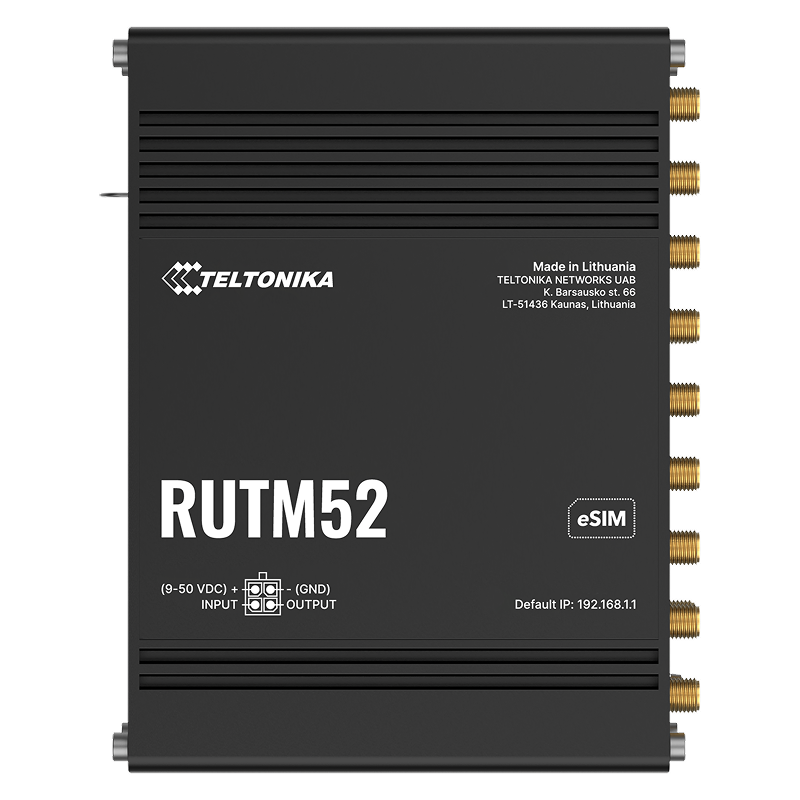
Future-proof
Do you want to know more about the product?
Contact us for a demo or if you have any questions.
